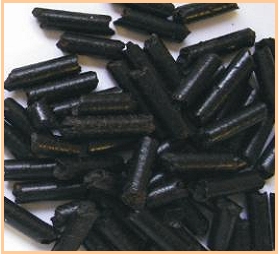Torrefaction Next Step in Bio Energy
By 250 News
 The BC Bioenergy Network and the Wood Pellet Association of Canada are looking into the feasibility of developing a pilot plant to commercially produce "torrefied pellets" from wood waste.
The BC Bioenergy Network and the Wood Pellet Association of Canada are looking into the feasibility of developing a pilot plant to commercially produce "torrefied pellets" from wood waste.
"Torrefied pellets (shown in photo at right) are made from the dry, blackened material that remains after forest biomass is exposed to extreme heat. This residue is then shaped into pellets or briquettes that pack much more energy density than regular wood pellets," says Forests and Range Minister Pat BellBell. "These enhanced pellets have the potential to make B.C.'s wood pellet industry even more competitive on a global scale."
The energy density of torrefied pellets is 22 per cent to 24 per cent higher than regular wood pellets. Due to their higher energy density, torrefied pellets represent a 40 per cent to 50 per cent reduction in transportation and storage costs compared to traditional wood pellets.
Torrefied pellets are also water-repellent, decrease fire risks in transportation and storage by generating less dust, and can be made from a wide range of raw biomass feedstocks. They are also more practical for converting coal-fired power stations in Europe, the world's largest market for pellet products.
Torrefaction involves a thermo-chemical conversion of biomass at 200 to 320 degrees Celsius in an oxygen-starved environment. During the process, water and combustible gases are removed from the biomass to produce fuel for heating and energy needs. Torrefied biomass is considered to be an improvement on current wood pellet products and an environmentally friendlier alternative than fossil fuel-based coal.
The BC Bioenergy Network and the Wood Pellet Association of Canada are now funding a $170,000 engineering study to determine if the technology is feasible on a commercial scale.
"Torrefaction is one of the most promising new technology applications for use in bioenergy," said BC Bioenergy Network executive director Michael Weedon. "Indications are that it will substantially improve the economics of wood pellet applications and accelerate replacement of fossil fuel-based coal with a more sustainable fuel source."
The feasibility study is expected to be complete later this fall. Funding possibilities for a pilot plant will be explored if the study determines that torrefaction technology is commercially feasible.
Eco-FuelsInc.net comparison of properties:
|
|
Wood Chips |
Torrefied Briquettes |
Coal
|
|
Bulk Density (lbs./ft3) |
6 |
44-62 |
52
|
|
Energy Density (BTU/lb.) |
9,500 |
11,000 |
12,000 |
|
Hygroscopic Nature |
Absorbs moisture |
Hydrophobic |
Hydropho |
|
Storage Behavior |
Rots |
Stable |
Stable
|
|
Grindability |
Non-Brittle |
Brittle, like Coal |
Brittle
|
Previous Story - Next Story
Return to Home











The first problem is that you must use a lot of energy to drive the water and gas out of the biomass. The second problem is what to do with the tar and other residues produced. The resulting form of charcoal burns relatively clean. The gas produced is methane which can also be burned.